翻译项目管理教材
工程项目管理双语教材(3篇)

第1篇IntroductionEngineering project management is a critical discipline that involves the application of project management principles, tools, and techniques to the planning, execution, and completion of engineering projects. This bilingual textbook aims to provide a comprehensive and practical guide for students and professionals in the field of engineering project management. The content is presented in both English and Chinese, catering to the diverse linguistic backgrounds of learners and ensuring a broader reach.Table of Contents1. Introduction to Engineering Project Management2. Project Life Cycle and Phases3. Project Planning- 3.1 Project Scope Management- 3.2 Project Schedule Management- 3.3 Project Cost Management- 3.4 Project Quality Management- 3.5 Project Resource Management- 3.6 Project Communication Management- 3.7 Project Risk Management4. Project Execution- 4.1 Project Team Management- 4.2 Stakeholder Management- 4.3 Contract Management5. Project Monitoring and Control- 5.1 Project Performance Measurement- 5.2 Change Management- 5.3 Conflict Resolution6. Project Closure7. Case Studies8. BibliographyChapter 1: Introduction to Engineering Project Management1.1 Definition and ImportanceEngineering project management refers to the application of project management principles, tools, and techniques to the planning, execution, and completion of engineering projects. It is essential for the successful delivery of projects within the constraints of time, cost, and quality.1.2 Key Concepts- Project: A unique set of activities designed to produce a product, service, or result with a defined beginning and end.- Project Management: The application of knowledge, skills, tools, and techniques to project activities to meet project requirements.- Project Manager: The person responsible for leading the project, managing resources, and ensuring the successful completion of the project.1.3 Objectives of Engineering Project Management- Scope: Define and manage the project scope to ensure that the project meets the specified requirements.- Time: Control the project schedule to ensure that the project is completed on time.- Cost: Manage the project budget to ensure that the project is completed within the allocated budget.- Quality: Ensure that the project deliverables meet the specified quality standards.- Risk: Identify, analyze, and manage project risks to minimize their impact on the project.Chapter 2: Project Life Cycle and Phases2.1 Project Life CycleThe project life cycle consists of four phases: initiation, planning, execution, and closure.2.2 Initiation PhaseThe initiation phase is the first phase of the project life cycle. It involves defining the project objectives, identifying stakeholders, and obtaining approval to proceed.2.3 Planning PhaseThe planning phase involves defining the project scope, developing a project schedule, estimating costs, identifying resources, and developing a project management plan.2.4 Execution PhaseThe execution phase is where the project plan is implemented. This phase involves managing resources, monitoring progress, and controlling changes to the project scope.2.5 Closure PhaseThe closure phase is the final phase of the project life cycle. It involves completing all project activities, documenting lessons learned, and obtaining formal acceptance of the project deliverables.Chapter 3: Project PlanningThis chapter delves into the various aspects of project planning, including scope, schedule, cost, quality, resources, communication, and risk management.3.1 Project Scope ManagementProject scope management involves defining and controlling what is andis not included in the project. It includes activities such as scope planning, scope definition, scope verification, and scope control.3.2 Project Schedule ManagementProject schedule management involves developing a project schedule, managing the schedule, and controlling changes to the schedule. It includes activities such as schedule planning, schedule development, schedule control, and schedule change control.3.3 Project Cost ManagementProject cost management involves estimating, budgeting, financing, funding, managing, and controlling costs throughout the project life cycle. It includes activities such as cost estimation, cost budgeting, cost control, and cost variance analysis.3.4 Project Quality ManagementProject quality management involves planning, implementing, and controlling quality to meet project requirements. It includes activities such as quality planning, quality assurance, quality control, and continuous improvement.3.5 Project Resource ManagementProject resource management involves acquiring, developing, and managing the resources needed for the successful completion of the project. It includes activities such as resource planning, resource acquisition, resource management, and resource control.3.6 Project Communication ManagementProject communication management involves planning, executing, and controlling the project communications according to the communications management plan. It includes activities such as communication planning, information distribution, stakeholder management, and communication control.3.7 Project Risk ManagementProject risk management involves identifying, analyzing, and responding to project risks. It includes activities such as risk identification, risk analysis, risk response planning, and risk monitoring and control.Chapter 4: Project ExecutionThis chapter focuses on the execution phase of the project life cycle, covering topics such as project team management, stakeholder management, and contract management.4.1 Project Team ManagementProject team management involves forming, leading, and managing the project team to achieve project objectives. It includes activities such as team building, team leadership, and team performance management.4.2 Stakeholder ManagementStakeholder management involves identifying, analyzing, and managing stakeholders' needs and expectations throughout the project life cycle. It includes activities such as stakeholder identification, stakeholder analysis, stakeholder engagement, and stakeholder communication.4.3 Contract ManagementContract management involves managing the contractual relationships between the project organization and its stakeholders. It includes activities such as contract planning, contract administration, and contract closure.Chapter 5: Project Monitoring and ControlThis chapter discusses the monitoring and control phase of the project life cycle, focusing on project performance measurement, change management, and conflict resolution.5.1 Project Performance MeasurementProject performance measurement involves monitoring and controlling the project to ensure that it is progressing according to the project management plan. It includes activities such as performance reporting, variance analysis, and corrective actions.5.2 Change ManagementChange management involves managing changes to the project scope, schedule, cost, and quality. It includes activities such as change request management, change control, and configuration management.5.3 Conflict ResolutionConflict resolution involves identifying, analyzing, and resolving conflicts among project stakeholders. It includes activities such as conflict analysis, negotiation, and mediation.Chapter 6: Project ClosureThis chapter covers the closure phase of the project life cycle, focusing on completing all project activities, documenting lessons learned, and obtaining formal acceptance of the project deliverables.Chapter 7: Case StudiesThis chapter includes real-world case studies that illustrate the application of project management principles and techniques in various engineering projects.Chapter 8: BibliographyThis chapter provides a list of references for further reading on engineering project management.ConclusionThis bilingual textbook on engineering project management aims to provide a comprehensive and practical guide for students and professionals in the field. By covering the essential concepts, tools, and techniques of project management, this textbook will help readers develop the skills and knowledge necessary to successfully manage engineering projects.第2篇前言随着全球经济的快速发展和国际合作的日益加深,工程项目管理作为一门综合性的学科,其重要性不言而喻。
(中英文版)项目管理培训 Project Management Training-15
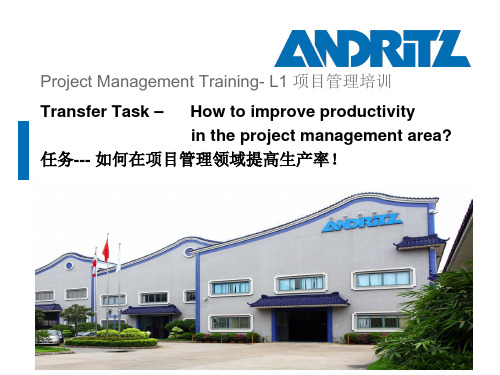
3
Leadership development LD1
Table of contents 目录
1. Objective & Concept 目标&理念
2. Productivity Analysis
生产率分析
3. Proposed Action Plan 推荐的行动计划 - Applicable Design – location oriented 适用的设计---因地制宜 - Risk Assessment 风险评估 - Capacity Plan Cross check 产能计划交叉互检 - Milestone Monitoring 里程碑节点的监控 - Communication Management 沟通管理 4. Executive Summary of proposed actions 推荐行动计划的执行总结
Concept 理念阶段
Planning 计划阶段
Execution 执行阶段
What are the main troubles for PM? 项目管理的主要问题? -OTP failure (Delay) 达不到准时交货率(延期) -Quality problems 质量问题 OTP and Quality failures are linked to each other
总体来说项目管理预估是基于以往项目的历史数据,同时以往延期交货及质量风险也应 作为参考考虑到预测中。
Same applies to the whole contract which shall reflect realistic conditions
同样,整个合同也应考虑以上问题,需反应实辅相成
工程项目管理中英文书
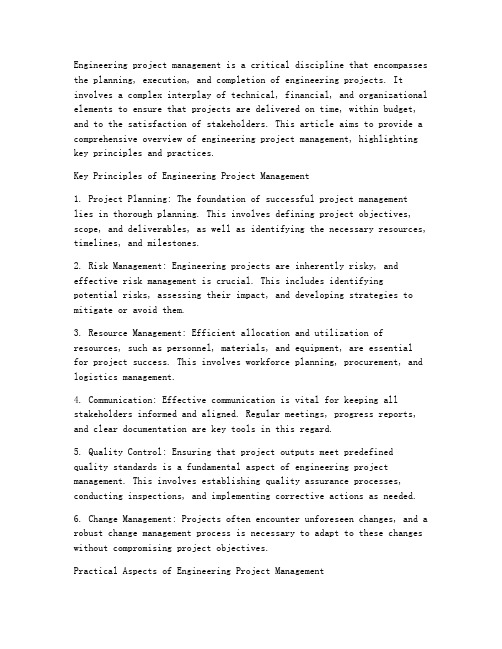
Engineering project management is a critical discipline that encompasses the planning, execution, and completion of engineering projects. It involves a complex interplay of technical, financial, and organizational elements to ensure that projects are delivered on time, within budget, and to the satisfaction of stakeholders. This article aims to provide a comprehensive overview of engineering project management, highlighting key principles and practices.Key Principles of Engineering Project Management1. Project Planning: The foundation of successful project managementlies in thorough planning. This involves defining project objectives, scope, and deliverables, as well as identifying the necessary resources, timelines, and milestones.2. Risk Management: Engineering projects are inherently risky, and effective risk management is crucial. This includes identifyingpotential risks, assessing their impact, and developing strategies to mitigate or avoid them.3. Resource Management: Efficient allocation and utilization of resources, such as personnel, materials, and equipment, are essentialfor project success. This involves workforce planning, procurement, and logistics management.4. Communication: Effective communication is vital for keeping all stakeholders informed and aligned. Regular meetings, progress reports, and clear documentation are key tools in this regard.5. Quality Control: Ensuring that project outputs meet predefinedquality standards is a fundamental aspect of engineering project management. This involves establishing quality assurance processes, conducting inspections, and implementing corrective actions as needed.6. Change Management: Projects often encounter unforeseen changes, and a robust change management process is necessary to adapt to these changes without compromising project objectives.Practical Aspects of Engineering Project Management1. Project Life Cycle: The project life cycle consists of several phases, including initiation, planning, execution, monitoring and controlling, and closing. Each phase has specific activities and deliverables that must be managed effectively.2. Tools and Techniques: Various tools and techniques are employed in engineering project management, such as project management software, Gantt charts, and critical path method (CPM) for scheduling and resource allocation.3. Stakeholder Management: Identifying and managing stakeholders' expectations and concerns is essential for maintaining their support and minimizing conflicts.4. Cost Management: Monitoring project costs and ensuring that they remain within budget is a critical task. This involves cost estimation, budgeting, and variance analysis.5. Performance Measurement: Regular performance measurement allowsproject managers to track progress, identify deviations from the plan, and take corrective actions as necessary.ConclusionEngineering project management is a dynamic and challenging field that requires a comprehensive understanding of technical, financial, and organizational aspects. By adhering to key principles and employing practical tools and techniques, project managers can ensure the successful delivery of engineering projects, contributing to the advancement of the industry and the satisfaction of clients and stakeholders.工程项目管理概述工程项目管理是一个涉及规划、执行和完成工程项目的关键学科。
翻译项目管理方案案例分析ppt课件

是此次项目只用了 3 周时间,是一个非常大的进步。
项目中,由于使用了计算机辅助翻译,实际翻译量从
为 30 万字左右。由于项目是出口设备,质量要求较
高,另外配备了专家,提高准确度与翻译质量。
24
2.2 项目信息 总结及归档
记忆库,术语库录入,待收到客 户满意度反馈表后进行项目归档。
25
风险分析
• 外部(客户) • 内部(翻译团队)
2.2 项目信息
•项目概述 •总结及归档
18
2.1 客户信息
基本信息
主要联系人: 电话: 电子邮件:
19
2.1 客户信息 客户满意度调查表
20
1.请详细填写以下背景 信息
公司名称 您的姓名 您的电子邮件地址 项目名称 《公司名称》项目号 《公司名称》主管项目经 理/协调员 《公司名称》项目经理所 属办公室 被调查项目的生产月份
11
译中
时间进度表
第1-2天:
•组建项目团队,确定团队相 关人员 •将一周的翻译量扫描成电子 版。 •根据专家建议,录入专业术 语库。 •译员熟悉稿件
12
译中
时间进度表
第3-6天
•译员开始翻译,两天交一次 稿件供译审审校和排版人员 排 •第6天译审交一次稿件
13
译中
时间进度表
第7-13天
•第7天第一次给客户提交稿 件,并要求客户对稿件质量 及时反馈,以便作出调整 •第7-13天,译员继续翻译, 两天交一次稿件,供译审审 校和排版人员排版
• 工作量:预计40万字
• 其他情况:原稿为纸稿,项目开 始一周后,客户方提供电子稿。 文件量大,图片、表格多,每张 图片中均有需要翻译的文字,稿 件专业性强,但受众为使用人群, 翻译文体应通俗易懂
翻译项目管理概述PPT课件

在项目、文件和语言层面“实时”监视服务器项目的项目进 度。
三、项目管理工具
创建新翻译项目 通过创建“项目文件包”为项目小组成员分配任务 运行项目报告 更新项目设置 将项目文件添加至现有项目 将翻译记忆库添加至现有项目 将术语库添加至现有项目 将已翻译的项目文件转换为已完成文件并交付给客户 将项目标记为完成。 在线共享项目。
翻译项目管理概述(PPT38页)
十六、准备项目
翻译项目管理概述(PPT38页)
翻译项目管理概述(PPT38页)
十七、准备就绪
翻译项目管理概述(PPT38页)
翻译项目管理概述(PPT38页)
第二章 翻译项目
§2.3 开始翻译项目
Type presentation name here in slide master
译员、审校员及其他小组成员
第二章 翻译项目
§2.2 创建新翻译项目
Type presentation name here in slide master
一、创建新项目
二、关于创建项目
可以选择基于模板或基于先前的项目创建项目。 指定项目设置并选择项目文件后,该向导会自动创建项目并将其 添加至 SDL Trados Studio,然后可以在其中管理该项目。 软件会在项目创建期间扫描文件,以确定其用途并指定相应的筛 选条件设置文件。
添加已有 翻译库
创建新翻译库
九、翻译记忆库和自动翻译设置
翻译项目管理概述(PPT38页)
九、翻译记忆库和自动翻译设置
翻译项目管理概述(PPT38页)
翻译项目管理概述(PPT38页)
项目管理书籍英文版
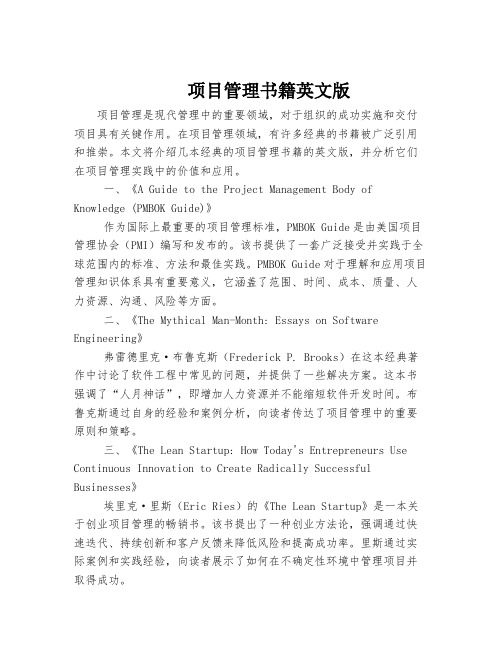
项目管理书籍英文版项目管理是现代管理中的重要领域,对于组织的成功实施和交付项目具有关键作用。
在项目管理领域,有许多经典的书籍被广泛引用和推崇。
本文将介绍几本经典的项目管理书籍的英文版,并分析它们在项目管理实践中的价值和应用。
一、《A Guide to the Project Management Body of Knowledge (PMBOK Guide)》作为国际上最重要的项目管理标准,PMBOK Guide是由美国项目管理协会(PMI)编写和发布的。
该书提供了一套广泛接受并实践于全球范围内的标准、方法和最佳实践。
PMBOK Guide对于理解和应用项目管理知识体系具有重要意义,它涵盖了范围、时间、成本、质量、人力资源、沟通、风险等方面。
二、《The Mythical Man-Month: Essays on Software Engineering》弗雷德里克·布鲁克斯(Frederick P. Brooks)在这本经典著作中讨论了软件工程中常见的问题,并提供了一些解决方案。
这本书强调了“人月神话”,即增加人力资源并不能缩短软件开发时间。
布鲁克斯通过自身的经验和案例分析,向读者传达了项目管理中的重要原则和策略。
三、《The Lean Startup: How Today's Entrepreneurs Use Continuous Innovation to Create Radically Successful Businesses》埃里克·里斯(Eric Ries)的《The Lean Startup》是一本关于创业项目管理的畅销书。
该书提出了一种创业方法论,强调通过快速迭代、持续创新和客户反馈来降低风险和提高成功率。
里斯通过实际案例和实践经验,向读者展示了如何在不确定性环境中管理项目并取得成功。
四、《Crucial Conversations: Tools for Talking When Stakes Are High》凯瑟琳·帕特森(Kerry Patterson)等人合著的《Crucial Conversations》是一本关于沟通技巧的重要书籍。
中文版教材项目管理

中文版教材项目管理 The document was prepared on January 2, 2021第一章绪论项目管理知识体系包含了许多内容,它是对项目管理专业知识的一个总结,正如法律、医药和会计等其它专业一样,这一知识体系也有赖于那些实践者和学者们对它加以应用和提高。
整个项目管理知识体系不仅包括那些已经被求证过的理论知识和已经被广泛加以应用的传统经验,而且还容纳了新的理论知识以及还没有被充分应用的先进经验。
本章将对几个关键术语进行定义和解释,并且给出全文的梗概,主要包括以下几个主要内容:1.1本文的目的1.2什么是项目1.3什么是项目管理1.4与其它管理方式的联系1.5相关的工作1.1本文的目的本文最根本的目的是要向大家介绍已经被普遍认可、接受的项目管理知识体系的基本内容。
"普遍认可"意味着在此所介绍的理论和实践经验在大多数时候对于大多数项目来讲都是适用的,这意味着大家对于这些理认和实践的价值用途已达成了广泛的一致。
但是,"普遍认可"并不是说这些理论和实践经验可以或者应该适用于所有的项目。
什么是对项目适用的,这应该由项目管理工作组做出决定。
作者也希望为大家探讨项目管理提供一本专业(术语)的通字典,项目管理是一个相对年轻的专业,因此在各种项目的实际运作中有大量相同类似的工作,但所使用的术语却很少相同。
本文为任何对项目管理感兴趣的人提供了一个基本的参考,主要适用于:(当然也不局限于此)·项目经理和项目组的其他人员·项目的客户和其他项目涉外人员·项目经理的主管·有下属参与项目工作的部门经理·进行项目管理和相关课程教学工作的教育工作者·项目管理及相关领域的顾问和专家·对项目管理人员进行培训的培训师由于本文在内容上还不够深刻和广泛,因此仅为大家提供了一个基本的参考。
附录E所讨论的是对项目管理应用的扩展,附录F 给出了有关项目管理上的进一步的信息采源。
Trados翻译项目管理 PPT

添加已有 翻译库
创建新翻译库
九、翻译记忆库和自动翻译设置
九、翻译记忆库和自动翻译设置
九、翻译记忆库和自动翻译设置
九、翻译记忆库和自动翻译设置
九、翻译记忆库和自动翻译设置
十、术语库指定(如果存在)
十一、SDL完全匹配设定
十二、项目准备
十三、批处理设定
十四、项目信息汇总
十五、项目设置
也可以在项目视图中创建其他模板。创建项目模板后,该模板将 显示在项目模板对话框中。
项目模板设置
语言对 翻译记忆库 术语库 AutoSuggest 词典 自动翻译服务器
文件类型设置 翻译记忆库设置 批处理设置 项目模板的文件扩展名为 *. sttpl。
六、项目详情
输入项目名称 项目描述主要标注项 目的简单提示信息
联机:联机工作流程将项目以服务器项目形式存储在项目服务器上 。然后,小组成员可以连接到服务器,以访问需要完成的工作。
在项目、文件和语言层面“实时”监视服务器项目的项目进 度。
三、项目管理工具
创建新翻译项目 通过创建“项目文件包”为项目小组成员分配任务 运行项目报告 更新项目设置 将项目文件添加至现有项目 将翻译记忆库添加至现有项目 将术语库添加至现有项目 将已翻译的项目文件转换为已完成文件并交付给客户 将项目标记为完成。 在线共享项目。
可选
发布项目至项目服务器 (SDL Studio GroupShare)。 生成翻译分析数据,以便在 SDL Trados Studio 中的屏幕上和 SDL Trados Studio 报告中进行查看。 将项目文件转换为 SDLXLIFF 格式。 通过应用翻译记忆库中的译文,对项目文件进行预翻译。 创建基于文件的项目翻译记忆库,以便与项目文件一起派发给项目组成 员。
一汽大众项目管理-中外文教学教材

Level 1 产品战略管理部
Produktstrategiemgmt.
产品部 规划部 销售 质保部 物流 控制部
PE
PL
SC QA
LO
CT
Level 1/Level 2
平台经理1
Plattformmanager1 PQ34
项目经理 Project manager
平台经理2 PQ32/PQ35
平台经理3 PQ35/PQ46
一汽-大众产品项目管理模式 Projektmanagemodell FAW-VW
一汽大众项目管理-中外文
一 汽-大 众 FAW-VOLKSWAGEN
1 of 27
一汽-大众产品项目管理模式 Projektmanagemodell FAW-VW
Audi公司与一汽-大众公司项目管理现状比较 Vergleich zwischen AUDI AG und FAW-VW bezueglich Projektmanagement
建立项目管理机构,并在实践中不断完善和发展
Aufbau der Organisationsstruktur fuer Projektmanagement, kontinuierliche Optimierung und Entwicklung
2.人员Personal
2. 人员Personal
具有项目管理经验的专业团队 Qualifizierte Fachmannschaft mit Projektmanagement-erfahrung
实线及其他相关说明 Erklaerung der Bedeutung von Linien und entsprechende Anweisung
实线表示行政隶属关系,即各平台经理在行政上隶属于产品战略管理部,向 产品战略管理部部长汇报。 Die Linie bedeutet disziplinarische Beziehung. D.h. Plattformmanager gehoeren disziplinarisch zu PM, und berichten an Senior Manager PM. 产品战略管理部部长与总经理签订KPI ,然后产品战略管理部部长再将KPI 指标分解到各个平台经理和其他科室。 Senior Manager PM unterzeichnet KPI mit Praesident. Dann bricht er die KPI-Kennzahlen an Plattformmanager und Unterabteilung unter. 车型经理、助理、翻译以及业务人员由产品管理部管理和提供 Produktmanager, Assistent, Dolmetscher und Sachbearbeiter werden von PM-Abteilung verwaltet und zu Verfuegung gestellt.
完整版Trados项目管理.pptx

§2.1 翻译项目管理
Type presentation name here in slide master
一、创建和管理翻译项目
SDL Trados Studio 是一个基于项目的翻译管理系统。 所有文件均作为项目的一部分进行翻译和管理。 项目可能包含要翻译为一种语言或多种语言的单个文件或多 个文件。 项目也可能包含参考资料、翻译记忆库、术语库、 AutoSuggest 词典以及给译员的翻译说明文字。 创建项目后,项目经理就可以使用 SDL Trados Studio 中 的项目管理工具管理项目工作的各个方面及监控项目进度。
可选
发布项目至项目服务器 (SDL Studio GroupShare)。 生成翻译分析数据,以便在 SDL Trados Studio 中的屏幕上和 SDL Trados Studio 报告中进行查看。 将项目文件转换为 SDLXLIFF 格式。 通过应用翻译记忆库中的译文,对项目文件进行预翻译。 创建基于文件的项目翻译记忆库,以便与项目文件一起派发给项目组成 员。
添加已有 翻译库
创建新翻译库
九、翻译记忆库和自动翻译设置
九、翻译记忆库和自动翻译设置
九、翻译记忆库和自动翻译设置
九、翻译记忆库和自动翻译设置
九、翻译记忆库和自动翻译设置
十、术语库指定(如果存在)
十一、SDL完全匹配设定
十二、项目准备
十三、批处理设定
十四、项目信息汇总
十五、项目设置
译员、审校员及其他小组成员
第二章 翻译项目
§2.2 创建新翻译项目
Type presentation name here in slide master
一、创建新项目
工程项目管理英文教材

IntroductionEngineering project management is a critical discipline that involves the planning, execution, and control of projects to achieve specific objectives within defined constraints. This textbook aims to provide a comprehensive overview of the principles, practices, and tools used in engineering project management. It is designed to serve as a valuable resource for students, professionals, and anyone interested in understanding and mastering the art of managing engineering projects effectively.Chapter 1: Introduction to Engineering Project ManagementThis chapter sets the stage for the study of engineering project management. It defines what a project is, the importance of project management in engineering, and the key roles and responsibilities of project managers. It also discusses the project life cycle and the various stages involved in managing a project from conception to completion.Chapter 2: Project PlanningProject planning is a fundamental aspect of engineering project management. This chapter delves into the process of creating a comprehensive project plan. It covers the following topics:- Scope Definition: Establishing the project's boundaries and deliverables.- Schedule Development: Creating a timeline for project activities.- Resource Allocation: Identifying and allocating resources needed for project execution.- Budgeting: Estimating costs and preparing a budget plan.- Risk Management: Identifying potential risks and developing mitigation strategies.Chapter 3: Project SchedulingEffective project scheduling is crucial for ensuring that project activities are completed on time. This chapter explores various scheduling techniques and tools, including:- Critical Path Method (CPM): Identifying the sequence of activitiesthat determine the project's duration.- Program Evaluation and Review Technique (PERT): Estimating activity durations and project completion times.- Gantt Charts: Visualizing project schedules and progress.- Project Management Software: Utilizing tools like Microsoft Project to manage schedules.Chapter 4: Project ExecutionProject execution is where the plan is put into action. This chapter covers the following aspects:- Team Management: Leading and motivating project team members.- Communication: Ensuring effective communication among stakeholders.- Procurement: Managing the acquisition of goods and services.- Quality Control: Ensuring that project outputs meet specified standards.- Change Management: Adapting to changes in project scope, schedule, or resources.Chapter 5: Project ControlProject control involves monitoring and adjusting the project's progress to ensure it stays on track. This chapter discusses:- Performance Measurement: Assessing project progress against the plan.- Variation Management: Handling changes in scope, schedule, or budget.- Conflict Resolution: Addressing conflicts that arise during project execution.- Project Closure: Documenting lessons learned and transitioning project deliverables to the client.Chapter 6: Project Risk ManagementRisk management is essential for identifying and mitigating potential threats to project success. This chapter covers:- Risk Identification: Identifying potential risks to the project.- Risk Analysis: Assessing the likelihood and impact of identified risks.- Risk Response Planning: Developing strategies to manage identified risks.- Risk Monitoring and Controlling: Continuously monitoring risks and adjusting responses as needed.Chapter 7: Project Quality ManagementEnsuring high-quality project outputs is a critical aspect of engineering project management. This chapter discusses:- Quality Planning: Defining quality standards and objectives.- Quality Assurance: Implementing processes to ensure quality is maintained.- Quality Control: Inspecting project outputs to ensure they meetquality standards.- Continuous Improvement: Identifying opportunities for improvingproject quality.Chapter 8: Project CommunicationEffective communication is key to the success of any project. This chapter covers:- Communication Models: Understanding different communication models and their application in project management.- Communication Plans: Developing plans to ensure effective communication among stakeholders.- Communication Tools: Utilizing tools like emails, meetings, andproject management software to facilitate communication.Chapter 9: Project Procurement ManagementProcurement management involves acquiring the necessary goods and services for project execution. This chapter covers:- Procurement Planning: Identifying procurement requirements and developing procurement strategies.- Supplier Selection: Selecting appropriate suppliers and vendors.- Contract Management: Managing contracts and ensuring compliance with terms and conditions.Chapter 10: Case Studies and Practical ApplicationsThis chapter includes real-world case studies and practical applications of engineering project management principles. It provides insights into how project management is applied in different industries and project types.ConclusionEngineering project management is a complex but essential discipline. This textbook provides a comprehensive framework for understanding and applying project management principles in engineering projects. By mastering the concepts and practices outlined in this textbook, readers will be well-equipped to manage projects effectively and achieve successful outcomes.AppendicesThe appendices include additional resources, such as templates, checklists, and guidelines for project management tasks.ReferencesThe references section provides a list of recommended reading materials for further exploration of engineering project management.。
《翻译项目管理实务》目录-王华伟编著
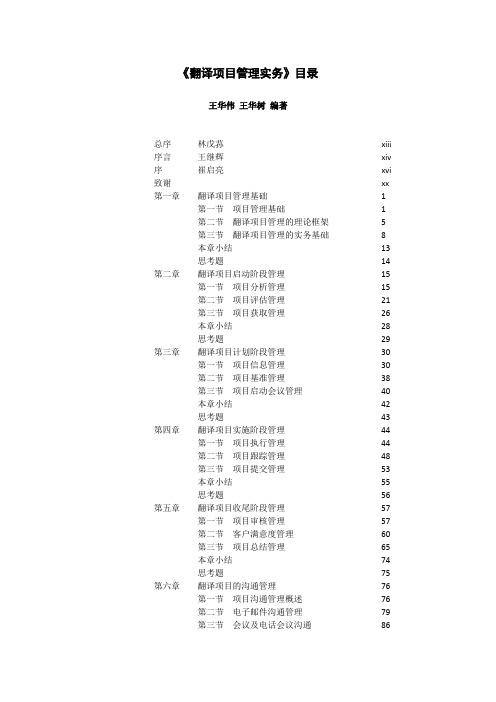
《翻译项目管理实务》目录王华伟王华树编著总序林戊荪xiii 序言王继辉xiv 序崔启亮xvi 致谢xx 第一章翻译项目管理基础1第一节项目管理基础1第二节翻译项目管理的理论框架5第三节翻译项目管理的实务基础8本章小结13思考题14第二章翻译项目启动阶段管理15第一节项目分析管理15第二节项目评估管理21第三节项目获取管理26本章小结28思考题29第三章翻译项目计划阶段管理30第一节项目信息管理30第二节项目基准管理38第三节项目启动会议管理40本章小结42思考题43第四章翻译项目实施阶段管理44第一节项目执行管理44第二节项目跟踪管理48第三节项目提交管理53本章小结55思考题56第五章翻译项目收尾阶段管理57第一节项目审核管理57第二节客户满意度管理60第三节项目总结管理65本章小结74思考题75第六章翻译项目的沟通管理76第一节项目沟通管理概述76第二节电子邮件沟通管理79第三节会议及电话会议沟通86第四节客户投诉管理88本章小结92思考题92第七章翻译项目的质量管理93第一节翻译质量管理概述93第二节翻译质量流程管理95第三节翻译质量实践管理102第四节翻译质量管理体系113本章小结116思考题117第八章语言资产管理118第一节语言资产概述118第二节术语管理121第三节翻译记忆管理125第四节语言资产管理系统128本章小结130思考题131第九章翻译项目的财务规程132第一节启动阶段的财务规程132第二节计划阶段的财务规程138第三节实施阶段的财务规程142第四节收尾阶段的财务规程144本章小结146思考题146第十章开始管理第一个翻译项目147第一节项目规划147第二节召开项目启动会议158第三节完善项目生产工具包163本章小结170思考题171第十一章基于MCAT分解体系编制WBS172第一节WBS概述172第二节MCAT分解体系结构175第三节WBS编制实例181本章小结186思考题186第十二章翻译生产中的工具运用187第一节翻译前处理189第二节翻译生产196第三节翻译后处理211本章小结216思考题217第十三章翻译项目管理系统概述218第一节翻译管理系统基础218第二节翻译管理系统主要功能220第三节典型的翻译管理系统224第四节翻译管理系统的选择与应用256本章小结259思考题259第十四章本地化项目管理实践260第一节项目计划:最显功力的是全局视野263第二节项目发包:多走一英里265第三节项目沟通:简明、扼要、规范268第四节项目跟踪:变是唯一的不变270第五节项目提交:巨细皆无遗271跋273参考文献275附录I小中型语言服务提供商组织架构277附录II大型语言服务提供商组织架构278附录III一般本地化翻译项目流程图279附录IV莱博智公司本地化项目流程图280附录V常见的翻译管理系统281。
翻译项目管理流程课件

翻译项目管理流程
8
定稿:根据需要,我们会对质量要求非常高(出版级)的 稿件,进行二次审校(主要是母语审校),以符合该国的 语言风格。
翻译项目管理流程
9
词汇收集:对相关的翻译项目,我们在翻译过程中会收集 相关翻译词汇,制定翻译词汇表,如:内部已编制《连铸 专业词汇表》、《轧钢专业词汇表》、《炼铁专业词汇 表》、《水利水电专业词汇表》等等。这是我们在翻译行 业大量的积累,厚积薄发,也让我们在以后的翻译中游刃 有余。
翻译项目管理流程
10
注意事项
时间尽量充足 翻译是一项艰苦、复杂的脑力劳动,投入的时间和翻译质
量往往成正比。如非加急件或特急件,请尽量给予我们充 足的时间。
原稿尽量清晰 原稿的文字和图像一定要清晰,要提供最终稿,最好是电
子文件。您在与人员确定及待翻译文件之后必须签订翻译 合同,同时确定付款方式;如存在疑问,请及时向人员咨 询并确定。
编辑排版:由专门的后期项目部门进行编辑排版,处理稿 件中的文字格式、、表格等,保证稿件格式与原文保持一 致。对各种应用软件,捷优翻译均能应付自由。应用软件 : Office、Pagemaker、Photoshop、Freehand、Framemaker、 A。crobatReader、CorelDraw、我们对稿件按的要求进行修改 所有修改将会存档,保证第二次翻译的准确性。
黄瑶玲 张含笑 杨浩天 汪雅文 汪洁
翻译项目管理流程
1
翻译项目管理简介
根据美国项目管理协会对项目的定义: 项目是为创造独特 的产品、服务或成果而进行的临时性工作。翻译工作是在 约定期限内,为满足客户需求而 创造出的独特知识产品。 因此,翻译工作属于项目范畴。
翻译项目管理计划书
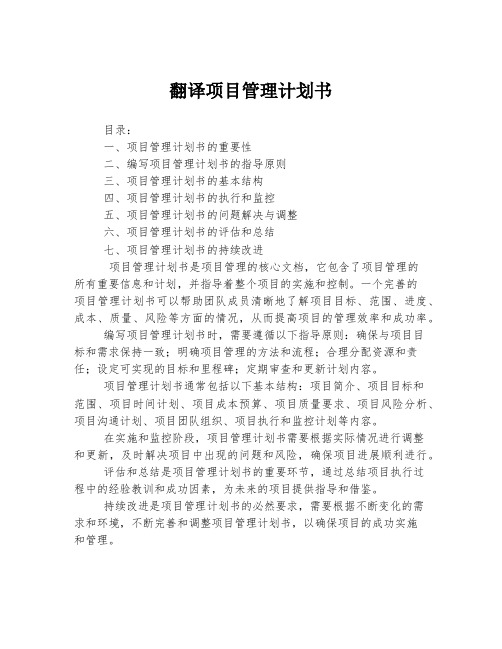
翻译项目管理计划书
目录:
一、项目管理计划书的重要性
二、编写项目管理计划书的指导原则
三、项目管理计划书的基本结构
四、项目管理计划书的执行和监控
五、项目管理计划书的问题解决与调整
六、项目管理计划书的评估和总结
七、项目管理计划书的持续改进
项目管理计划书是项目管理的核心文档,它包含了项目管理的
所有重要信息和计划,并指导着整个项目的实施和控制。
一个完善的
项目管理计划书可以帮助团队成员清晰地了解项目目标、范围、进度、成本、质量、风险等方面的情况,从而提高项目的管理效率和成功率。
编写项目管理计划书时,需要遵循以下指导原则:确保与项目目
标和需求保持一致;明确项目管理的方法和流程;合理分配资源和责任;设定可实现的目标和里程碑;定期审查和更新计划内容。
项目管理计划书通常包括以下基本结构:项目简介、项目目标和
范围、项目时间计划、项目成本预算、项目质量要求、项目风险分析、项目沟通计划、项目团队组织、项目执行和监控计划等内容。
在实施和监控阶段,项目管理计划书需要根据实际情况进行调整
和更新,及时解决项目中出现的问题和风险,确保项目进展顺利进行。
评估和总结是项目管理计划书的重要环节,通过总结项目执行过
程中的经验教训和成功因素,为未来的项目提供指导和借鉴。
持续改进是项目管理计划书的必然要求,需要根据不断变化的需
求和环境,不断完善和调整项目管理计划书,以确保项目的成功实施
和管理。
- 1、下载文档前请自行甄别文档内容的完整性,平台不提供额外的编辑、内容补充、找答案等附加服务。
- 2、"仅部分预览"的文档,不可在线预览部分如存在完整性等问题,可反馈申请退款(可完整预览的文档不适用该条件!)。
- 3、如文档侵犯您的权益,请联系客服反馈,我们会尽快为您处理(人工客服工作时间:9:00-18:30)。
行业数据——5
传神——中国首席语言服务商 中国奥委会官方网唯一多语合作伙伴
翻译公司前100强分析
• 1、前20强上市公司仅4家(美国1,英国2,日本1) • 2、前10强公司员工数量最少为605人,前20为200人。 • 3、前20强人均产值最低4.58W,最高27.6W(第25名33W,
产业机遇
模式 技术 管理
语联网
根本改变 创新业态
云翻译等 流程规范等
可以提升 企业素质
创新 业态 的机会
建立 产业链 的机会
语言服务机构目前全球发展基本类似:
1、中国超过12000家,处于低层次竞争 2、国外也是小而分散,全球最大企业年营业额 也不过4亿多美元,与其他行业是比较小的
互联网和经济一体化必然诞生:
• 优点:具有品牌,核心竞争力强,营销能力强,质量控制能力强。可胜任大 型项目。抗风险能力强。处于产业链的上端,可以影响中下游的发展,具备 一定的话语权。
• 问题:管理运营成本高,无价格优势。对企业的管理层要求更高,战略一旦 发生错误,或者管理上出现重大失误,可能会功亏一篑。
传神——中国首席语言服务商 中国奥委会官方网唯一多语合作伙伴
满意度调查
出厂质检
项目提交
传神——中国首席语言服务商 中国奥委会官方网唯一多语合作伙伴
口译项目的基本流程
传神——中国首席语言服务商 中国奥委会官方网唯一多语合作伙伴
外派项目基本流程
传神——中国首席语言服务商 中国奥委会官方网唯一多语合作伙伴
笔译项目管理 问题:项目准备从何时开始?
从发现销售机会开始准备。
翻译项目管理
主讲人:闫栗丽
传神——中国首席语言服务商 中国奥委会官方网唯一多语合作伙伴
课程内容
• 翻译公司的类型和特点 • 翻译项目分类 • 各类项目的基本流程 • 笔译项目管理
传神——中国首席语言服务商 中国奥委会官方网唯一多语合作伙伴
翻译公司的类型及特点
• 个体户类:个人行为,通常是 自由译者或者翻译主导,活做 不完的时候找些帮手。没有固 定员工,没有企业正式的办公 场地。
• 翻译方向,要求提交时间; • 客户对稿件的要求:排版要求(提交格式、是否需要打印、
刻录光盘等); • 译员是否充足; • 大型项目需要拆分成几个项目经理进行处理,是否有足够
的人选 • 对于复杂项目 ,还需要了解客户方其他环节的时间安排,
以便协助客户做出正确的时间规划,为每个环节争取更为 合理的时间
传神——中国首席语言服务商 中国奥委会官方网唯一多语合作伙伴
市场问题:同质化竞争
客户
很满意 2%
很不满意 23%
不满意 29%
满意 14%
一一般 32%
低水平同质化竞争
客户满意率低
标准化 人才供给
当前绝大多数企业的实际水平 实现产业化大发展所需的水平
信息技术
传统模式下产业升级缓慢
传神——中国首席语言服务商 中国奥委会官方网唯一多语合作伙伴
✓
参考级
✓
专业级
✓
出版级
• 客户是否提供参考文件/术语;
• 客户提供的原文稿件格式是否需要特殊处理;
• 了解:专业,难度,质量要求或规范
• 客户方是否有指定的项目接口人
传神——中国首席语言服务商 中国奥委会官方网唯一多语合作伙伴
启动——项目需求了解-2 :
• 文件是否有问题(文中字迹不清,缺页,原文文字出现质 错误,原文重复等),立即向客户反馈;
语言服务领域的新业态和超大规模 企业
传神——中国首席语言服务商 中国奥委会官方网唯一多语合作伙伴
2015年国际翻译日主题
变化中的翻译职业
传神——中国首席语言服务商 中国奥委会官方网唯一多语合作伙伴
行业数据——1
The Revenue Distribution of LSP Offerings in 2015 Source: Common Sense Advisory, Inc.
是否需要培训,如果不能培训怎么办 • 财务:客户是否有预付款、成本估算、项目过程中需要垫
付的资金、风险资金等
传神——中国首席语言服务商 中国奥委会官方网唯一多语合作伙伴
启动——项目需求了解-1 :
• 项目类型:
➢ 笔译类型:外包、现场、保密、审校、翻译、改译、编译等
• 项目的目的或者用途(用于什么场合,给什么人看)
传神——中国首席语言服务商 中国奥委会官方网唯一多语合作伙伴
启动——稿件分析:
• 内容:专业,难度,质量要求或规范 • 计算:字数,译员/审校数量 • 复用:同参考文件比对,文件之间/同一文件内部比对,
标红处理 • 排版:所需时间/软件,是否需要译前排版 • 保密:是否需要消密 • 时间:译前处理/稿件对比/翻译/审校(质检)的时间比
盲目创业的困惑
• 1. 公司从09年底注册到现在。原来2个人合资,现在那个合伙人不堪重负已经撤资,我一个人在做 。
• 2. 公司一直没有太多业务,因为内陆省份的缘故吧。 • 先说口译,西安的国际会议不多,这两年虽有上升趋势,但跟北京上海沿海等地不能比。即使有,
一般这些会议掌握在很多会议公司和设备公司手里。所以,翻译公司能拿到活的不多。 • 再说笔译,笔译更难。西安本地翻译公司也不少,更不提全国性的公司在西安的扩张。笔译有几
• 优点 :成本低,风险低,管理简单 。
• 问题:规模太小,大活接不了,小活 吃不饱。团队成员不稳定。生存质量 差。
传神——中国首席语言服务商 中国奥委会官方网唯一多语合作伙伴
翻译公司的类型及特点
• 中小型公司:岗位有分工,有专职 销售和PM,公司一定数量的翻译人 员,大部分业务依靠外部兼职译员 完成,公司规模大概20~100人以内 ,
• 优点:无门槛,成本低。 • 问题:译员要自己做翻译,还
要找业务。如果没有稳定长期 的客户,生存环境恶劣。因此 大部分自由译者长期挂靠在一 个或几个合作稳定的翻译公司 。
传神——中国首席语言服务商 中国奥委会官方网唯一多语合作伙伴
翻译公司的类型及特点
• 工作室类:由几个翻译组成的小翻译 团队。通常固定为某个或者某类客户 服务。有的成为为某些大型翻译公司 的供应商。公司除了译员,没有其他 岗位的专业分工,老总兼销售和PM。
传神——中国首席语言服务商 中国奥委会官方网唯一多语合作伙伴
启动——前期译员准备
• 做好译员资源预估和储备规划 • 确定可能的专业技术和语言质量负责人选(审校+定稿) • 试译 (考察点:完成时间,合作态度,询问期望价格/擅长方向,
是否有低级错误/语言流畅程度/专业性)
注意:资源不总是充足的,而且常常是紧缺的,且不确 定因素非常多,怎么办?你是否能将变不可能为可能?— —这常常是成为竞争中取胜的关键点 (举例:3个月内找到20名有汽车翻译经验的法语译员到东 风汽车现场工作2年,解决方案是什么?)
• 优点:专注做自己擅长的事情 ,质量稳定,人员相对稳定, 业务稳定。
• 缺点:不掌握终端客户,利润 偏低。只能走薄利多销的路线 。
客户
大型翻译 中国奥委会官方网唯一多语合作伙伴
翻译公司的类型及特点
• 大中型公司:员工数量100人以上,部门专业化分工明确,有自己的质量控制 体系,有译员评价体系,有专业的营销部门,有较为系统的内部培训体系。 因为有一定数量的专职译员和专家,所以有能力承接大型的项目和紧急项目 。在不同城市设立有分支机构。这样的公司在外部有大量的兼职译员和供应 商,确保能满足他们大量的业务需求。
传神——中国首席语言服务商 中国奥委会官方网唯一多语合作伙伴
真实的故事-1
传神——中国首席语言服务商 中国奥委会官方网唯一多语合作伙伴
真实的故事-2
传神——中国首席语言服务商 中国奥委会官方网唯一多语合作伙伴
真实的故事-3
传神——中国首席语言服务商 中国奥委会官方网唯一多语合作伙伴
真实的故事-4
例 • 工具:是否需要使用工具 • 培训:是否需要对译员做培训等。
• 优点:公司比个人更有竞争力。
• 缺点:因为有经营压力,所以有的 公司什么活都接,什么语种都敢接 。喜欢打价格战,质量控制不稳定 ,客户流失率比较高。大活接不了 ,小活吃不饱。
客户 客户
客户
传神——中国首席语言服务商 中国奥委会官方网唯一多语合作伙伴
翻译公司的类型及特点
• 生产型公司:也有的公司定位 自己是只做翻译生产,不做直 接客户的。他们因为地处偏远 或老总不擅长营销,所以索性 专门给大型翻译公司做供应商 。
第56名46W)
作业:
请研究如下三家公司的商业模式,谈谈你对他们的商业模式的看法: Lionbridge Logos Group
Apostroph Group Honyaku Center Inc.
传神——中国首席语言服务商 中国奥委会官方网唯一多语合作伙伴
翻译项目管理
• 项目经理按照客户的要求,在既定的时间内,协调组 织相关资源,保质保量的完成翻译任务,并将成本控 制在预期的合理范围内。
个大问题,不像口译,不是所有人都敢上。笔译的译者,不管水平如何,都敢上,很多的是夫妻店 ,拿回家自己两个人翻,要么就是找学生,很低的价格,甚至还有直接机器翻译的。这个行业里很 乱,质量也没有人监管,客户只要是报价低就可以接受,因为没人懂外语。业务少,报价低,像我 这样正规的公司就几乎没有利润可言。比如,西安的笔译价格在120-150中间,给译者,能保证质 量的译者,70-90,译审20,行政、税费,翻译公司所剩无几。所以,目前的生存环境比较危险。 • 再有,笔译的活也不是掌握在翻译公司手里,比如像政府的一些会议或者资料,都是交给印刷厂 去找人翻译,人家一般都是知道谁学英语的,找个熟人就翻了。 • 3. 翻译公司一般都要兼营其他项目,比如培训,但现在培训也都需要资质。我以前做培训的,也 知道市场很大,很好,但我目前不想做。 • 4. 目前,只能扩展做一些相关的服务,比如会议、会务、会展。我不知道下一步怎么弄。 • 5. 我知道很多公司都是做本地化,但我没有业务来源,所以我暂时还不懂。 • 6. 关于TRADOS等辅助工作,到底用处有多大。我一直没用过,但很多原来用的人,现在也转向还 是自己翻译为主。更多的应该是团队合作用的多吧。
